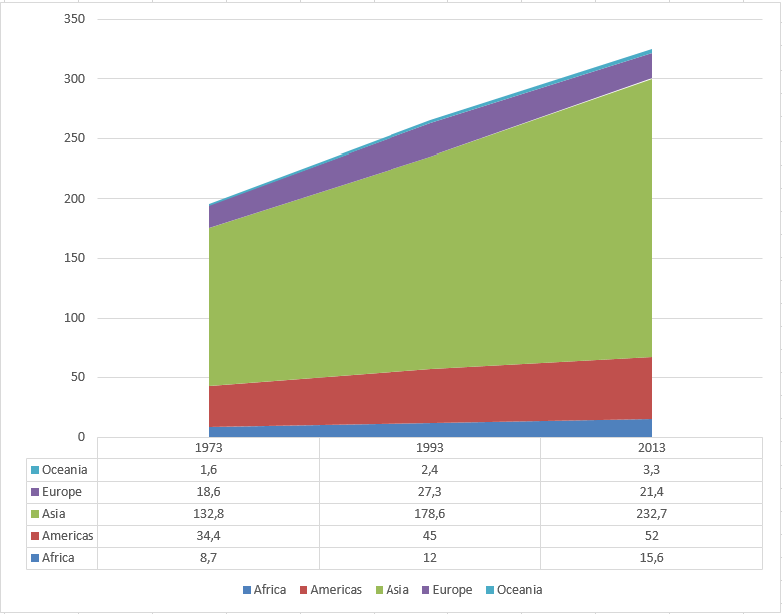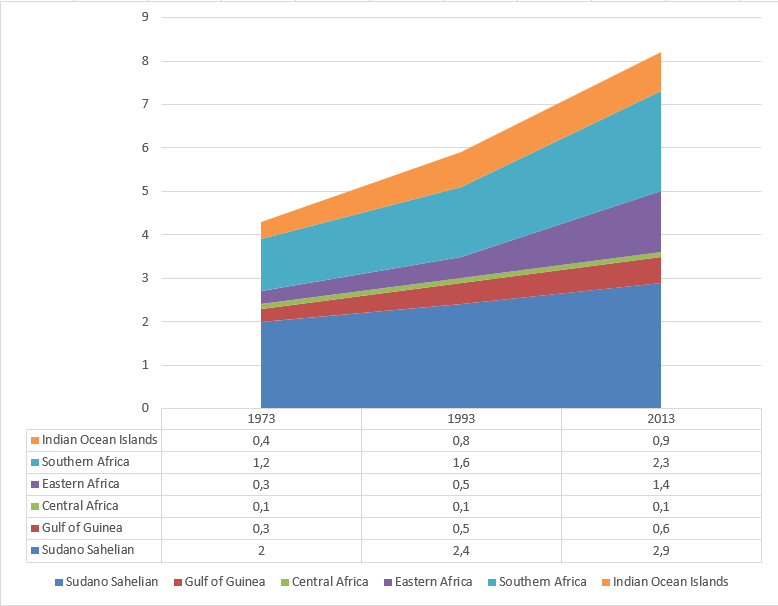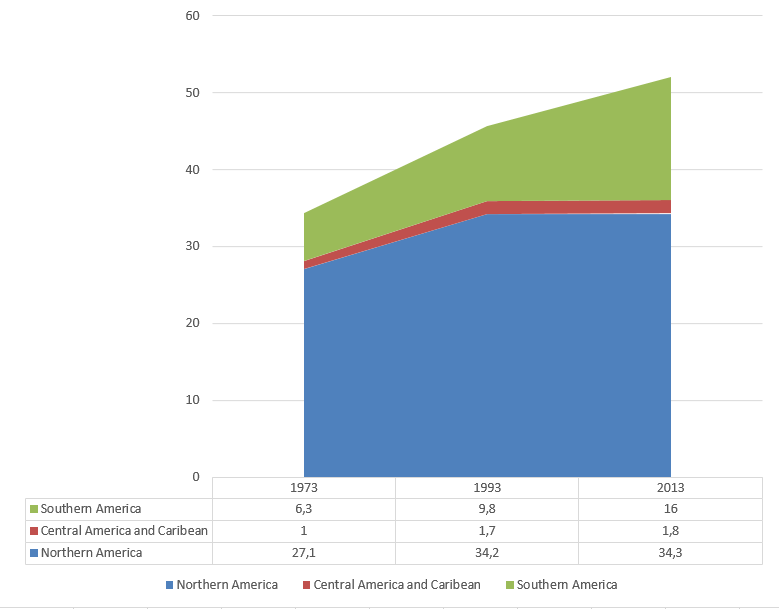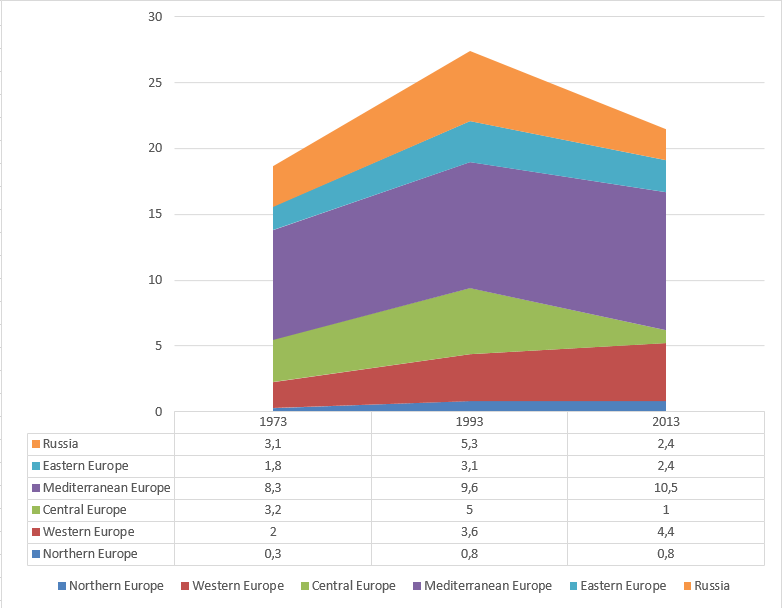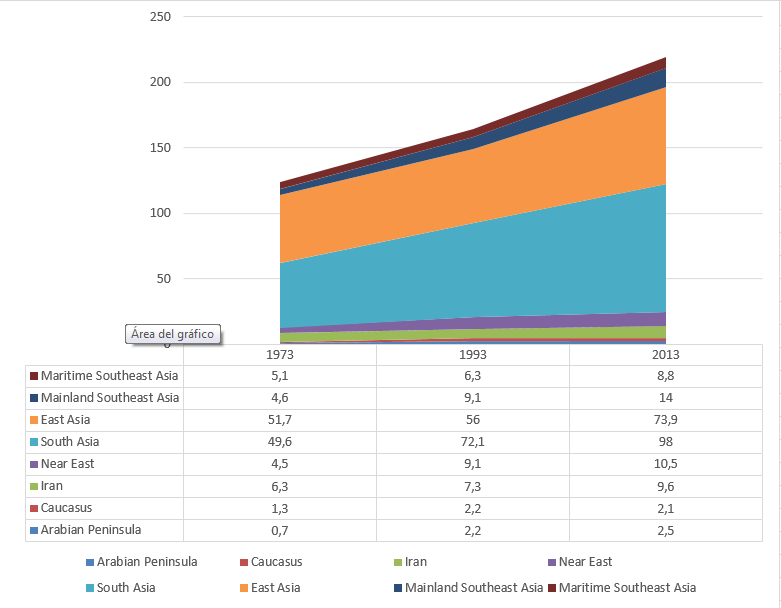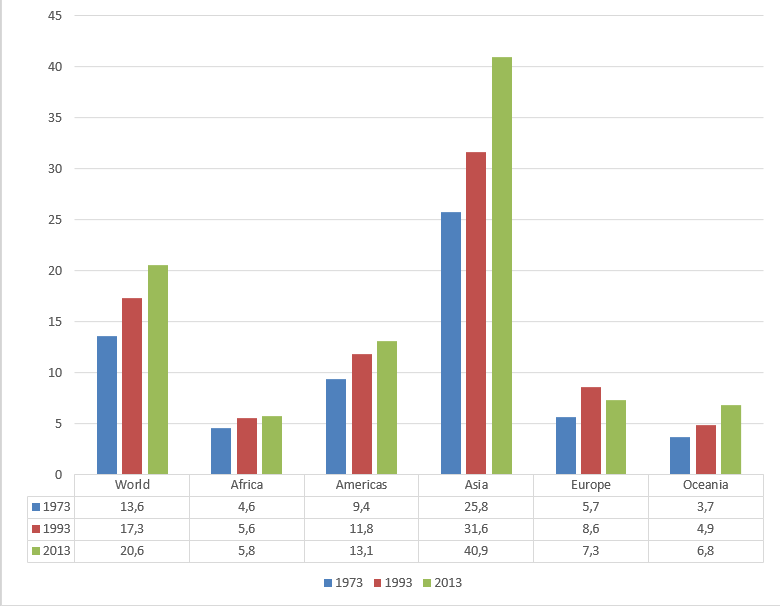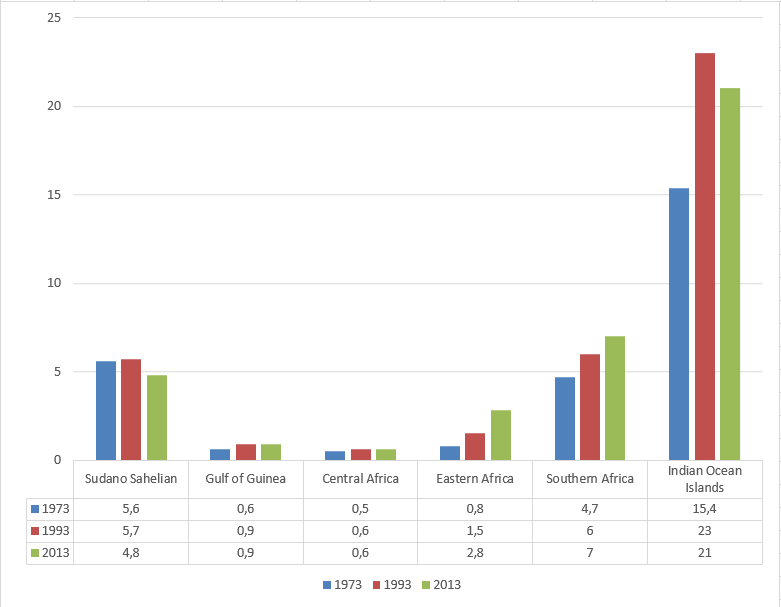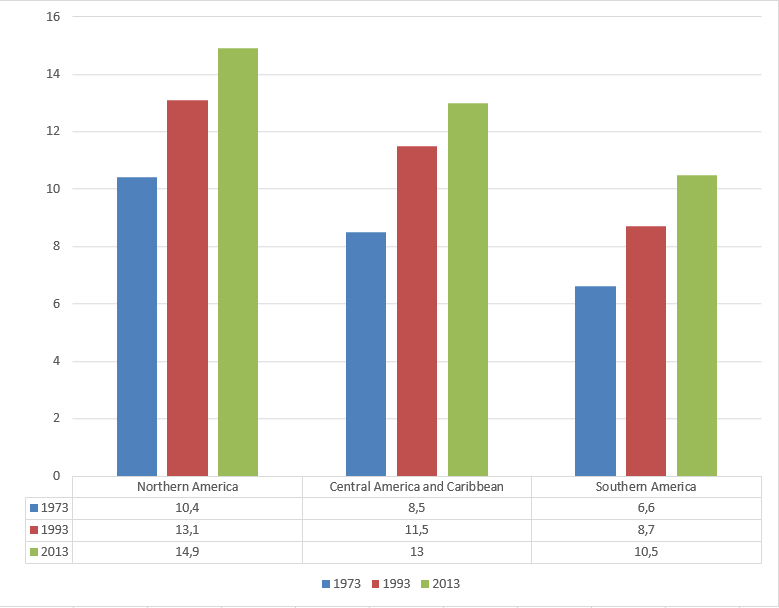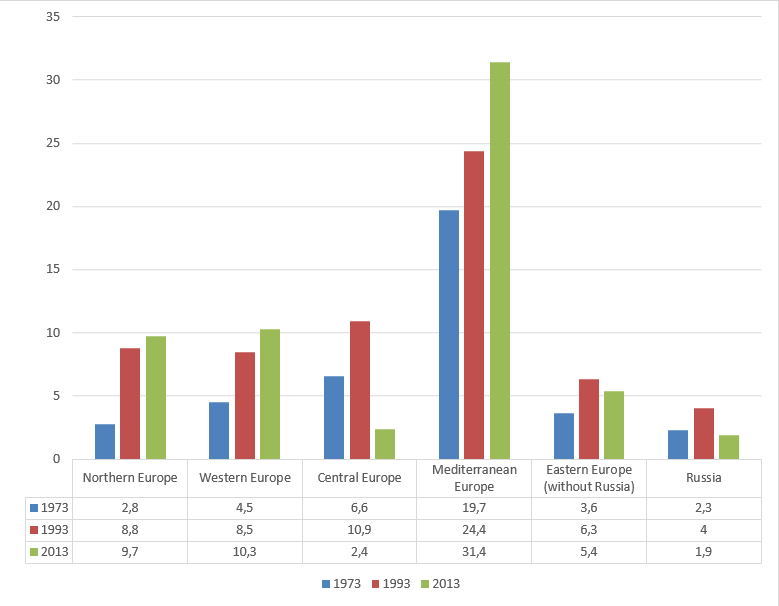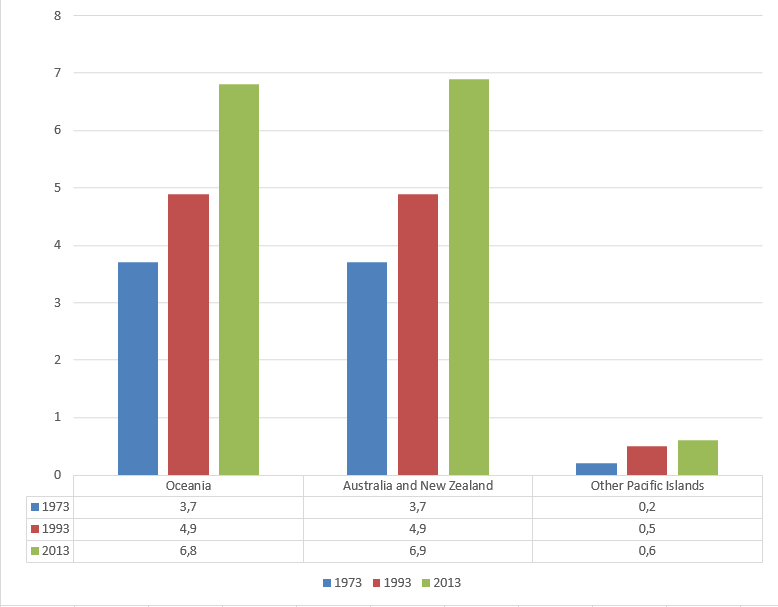Timeline of irrigation
From Timelines
This is a timeline of irrigation, attempting to describe major irrigation projects across time, and the evolution of irrigated area.
Contents
Big picture
| Time period | Development summary |
|---|---|
| Ancient times | Irrigation is known to have been practised already more than four thousand years ago. The Euphrates and Tigris rivers are the cradle of the early Mesopotamian civilizations and irrigation with their water make development of agriculture possible. In Egypt, floodwater from the Nile is already used for cultivation during pharaoh period.[1] Domestic wastewater is used for irrigation by the mesopotamians, Indus valley, and Minoan civilization. Also, wastewater is used for disposal, irrigation, and fertilization purposes by Hellenic civilizations and later by Romans in areas surrounding cities (e.g. Athens and Rome).[2] "Moreover, in China, use of human excreta for fertilizing agricultural crops has been practiced since ancient time."[3][4] Terrace irrigation is developed in pre-Columbian America, early Syria, India and China.[5] |
| From the 1930s to 1950s huge government-sponsored programs are initiated in the United States, Soviet Union, Australia, and Africa to build dams for hydropower, flood control, irrigation, and to encourage settlement and stabilization of sparsely populated frontiers.[6] In the 1960s and 1970s irrigation becomes a key component of the Green Revolution, which stabilizes food production in the developing world. This would provide a new tier of nations the opportunity to turn some of their monetary and human resources to non agricultural avenues of economic and social development.[6] Localized irrigation would grow rapidly since the invention of cheap plastic pipes in the 1970s.[1] From the 1980s a decrease in the rate of irrigation development makes the rate of increase of worldwide food production to drop in the following decades[6] (see graphs below). | |
| Recent years | Approximately 70% of all water abstracted from rivers, lakes and aquifers is used for irrigation.[7] The Asian continent, with almost 230 million hectares equipped for irrigation, represents just over 70% of the irrigation area worldwide. China is the country with the largest area equipped for irrigation, with 69.4 million hectares, immediately followed by India with 66.7 million ha.[1] As of 2017, Libya has the world's largest irrigation project.[8] |
Full timeline
| Year | Event type | Details | |
|---|---|---|---|
| Holocene epoch (about 10,000 years ago) | Background | The development of agriculture occurs.[9] | |
| 6000 BC | System | Early irrigation occurs at about the same time in Egypt and Mesopotamia using the water of the flooding Nile or Tigris/Euphrates rivers. The flood waters, occurring from July through December, would be diverted to fields for 40 to 60 days, being further drained back into the river at the right moment in the growing cycle.[10] | Egypt, Irak, Iran |
| 3200 BC – 1300 BC | System | Irrigation is developed in the Indus Valley Civilization.[11] | India |
| 3200 – 1100 BC | System | Domestic wastewater is used for irrigation by civilizations in the Mesopotamia, Indus valley, and the Minoan civilization.[12] | |
| 3100 BC | Early pictorial representation of irrigation appears in Egypt.[6] | Egypt | |
| 2500 BC | Technology | In Egypt, copper pipes are used for irrigation.[11] | Egypt |
| 2000 BC – 1000 BC | Coverage | In sub-Saharan Africa, irrigation reaches the Niger River region cultures and civilizations. Irrigation is based on wet season flooding and water harvesting.[5] | |
| 800 BC | Technology | The Qanats are developed in ancient Persia. These are considered among the oldest known irrigation methods still in use today.[5] | Iran |
| 600 BC – 500 BC | Technology | In precolumbian Mexico, storage dams are constructed of blocks mortared together. Some of the dams can be classified as arch dams. An improved type of canals is maintained. Different cross-sectional areas are used, and some were lined with stone slabs. During this time, crops are irrigated with carefully controlled water.[9] | Mexico |
| 474 BC – 367 BC | Coverage | Irrigation works develop in the reign of Pandukabhaya of Anuradhapura in Sri Lanka, and would remain under continuous development for the next thousand years, becoming one of the most complex irrigation systems of the ancient world.[5] | Sri Lanka |
| 300 BC | Technology | Farming communities in Balochistan, and Kutch, India, use rainwater harvesting for agriculture and many other uses. | |
| 256 BC | System | The Dujiangyan Irrigation System is built in Sichuan, China to irrigate an enormous area of farmland that today still supplies water.[5] | China |
| 1500 | Technology | In Hama, Syria, there are a series of water driven wheels of various diameters, that lifts the river water to an aqueduct at a higher level for drinking and irrigation purposes.[13] | Syria |
| 1847 | Technology | Early modern irrigation technology is developed in the Mormon settlement of the Utah Great Salt Lake Basin, with an eventual cultivation of nearly 2.5 million hectares irrigated across the inter-mountain western United States by the turnof the century.[6] | United States |
| 1900 | Coverage | More than 3 million hectares are under irrigation in the Aral Sea basin.[14] | Kazakhstan, Uzbekistan |
| 1905 | Project | The Lower Yellowstone Irrigation project is started (it's still being used today), with the purpose of maintaining a water right from the Yellowstone River, divert it at Intake Dam, transport it through a 74 mile long carriage system along the west side of the Lower Yellowstone Valley and distribute it to local farmers.[15] | United States |
| 1915 | Program launch | Canadian provincial governments start helping local communities organize irrigation developments. This would result in rapid increases in irrigated areas.[16] | Canada |
| 1918 | Program launch | The Soviet government decides that the two rivers that feed the Aral Sea, the Amu Darya and the Syr Darya, would be diverted to irrigate crops of cotton, melons, and citrus in the deserts of Kazakhstan and Uzbekistan. This would be the turning point towards the dissapearance of the Aral Sea.[17] | Kazakhstan, Uzbekistan |
| 1925 | Project | The Gezira irrigation scheme is started by the British colonialists in Al Jazirah State, Sudan. It uses water from River Nile which is based on gravity irrigation. Gezira Irrigation Scheme covers an area of 0.88 million hectares which is about 50 percent of the irrigated land in Sudan. Cotton, sorghum, wheat and vegetables are grown in the area. It is one of the biggest irrigation schemes in the world, with over 100,000 farmers.[18] | Sudan |
| 1932 | Project | The Office du Niger is created as an autonomous public enterprise that administers a large irrigation scheme in the Ségou Region of Mali. The water, which comes from the niger river, is used to irrigate nearly 100,000 hectares of flat alluvial plains. Rice is the main crop grown in the irrigation scheme.[19] | Mali |
| 1934 | Project | Vaalharts Irrigation Scheme is started in the actual Northern Cape Province, South Africa. It is the largest irrigation scheme in the country, covering about 36,950 hectares of land. It has 1,040 farmers. The irrigation scheme is named after the Harts and Vaal Rivers, where it draws its water from.[20] | South Africa |
| 1935 | Technology | American manufacturer Rain Bird introduces the first impact sprinkler to the market.[21] | United States |
| 1950 | Statistics | The worldwide total irrigated area reaches about 94 million ha.[6] | |
| 1953 | Project | The Mangalam Medium Irrigation Project is developed in the Indian state of Kerala. Commenced in 1953, the project is completed in the 1962.[22] | India |
| 1956 | Project | Mwea Irrigation Scheme is started in the Kirinyaga County, Kenya. It covers 7,952 hectares and gets water from the Nyamindi and Thiba Rivers. Rice is the main crop grown. The irrigated land produces more than 60 percent of rice grown in the country.[23] | Kenya |
| 1960 | Coverage | 5 million hectares are under irrigation in the Aral Sea basin. Consumptive withdrawals for it reaches an estimated 40 km3.[14] | Kazakhstan, Uzbekistan |
| 1969 | Program launch | Brazil launches its Pluri-annual Irrigation Programme (PPI). In the following decades, the growth of irrigated areas would accelerate in the country.[24] | Brazil |
| 1970 | Coverage | The worldwide total irrigated area grows to 198 million ha by 1970, up from 94 million ha in 1950.[6] | |
| 1970 | Project | The Aswan High Dam opens, about 5 kilometers upstream from the original Aswan Dam, impounding the waters of the Nile to form Lake Nasser, the world’s third-largest reservoir, with a capacity of 5.97 trillion cubic feet. The project required the relocation of thousands of people and flooded some of Egypt’s monuments and temples, which would later be raised. The new Aswan High Dam controls annual floods along the Nile, supplies water for municipalities and irrigation, and provides Egypt with more than 10 billion kilowatt-hours of electric power every year.[25] | Egypt |
| 1980 | Organization | The United Kingdom Irrigation Association is launched following a spate of very dry years and the publication of the Strutt Report "Water for Agriculture: future needs", which predicts rapid growth in irrigation in the country. As a result, irrigated agriculture would gradually grow in importance in the following decades.[26] | |
| 1981 | Coverage | Localized irrigation covers almost 0.5 million hectares worldwide.[1] | |
| 1990 | Coverage | The world total irrigated area grows to about 220 million ha.[6] | |
| 1991 (August) | Project | The first phase of the Great Man-Made River, –a network of pipes that supplies water to the Sahara in Libya, is inaugurated. The Great Man-Made River would be described as the world's largest irrigation project.[27] | Lybia |
| 1996 | Coverage | The world total irrigated area grows to 263 million ha.[6] | |
| 1999 | Award | The UNESCO awards Libya a prize for notable scientific research regarding the use of water in desert areas.[8] | Libya |
| 2004 | Project | The construction of the Polavaram Project, –a multi-purpose irrigation project in Andhra Pradesh, India, begins.[28] | India |
| 2008 (April 24) | Canal | The Narmada canal is inaugurated. Located in northwestern India, it is the largest and longest irrigation canal in the world.[29][30] | India |
| 2010 | Coverage | Localized irrigation covers almost 9 million hectares worldwide. Sprinkler irrigation equips more than 35 million ha in the same year. Although considered less efficient than localized irrigation, both its cheaper prices and potential mobility explain its wider expansion.[1] | |
| 2010 | Ranking | China becomes the country with the largest irrigation area, overtaking India which ranked first for over 50 years.[1] | China |
| 2012 | Project | Galana-Kulalu Food Security project is launched in Kilifi and Tana River Counties, Kenya. Funded by the Kenyan and Israeli governments, it is the largest irrigation project in the country covering 400,000 hectares. The irrigation scheme has fish, livestock and crop production.[31] | Kenya |
| 2012 | Coverage | Worldwide, over 324 million hectares are equipped for irrigation, of which about 85% (about 275 million ha) are actually irrigated.[1] |
Visual data
Meta information on the timeline
How the timeline was built
The initial version of the timeline was written by User:Sebastian.
Funding information for this timeline is available.
What the timeline is still missing
Timeline update strategy
External links
Major irrigation projects in India
See also
References
- ↑ 1.0 1.1 1.2 1.3 1.4 1.5 1.6 "Irrigation areas, irrigated crops, environment". fao.org. Retrieved 24 November 2017.
- ↑ Tzanakakis, V. E.; Paranychianaki, N. V.; Angelakis, A. N. (1 March 2007). "Soil as a wastewater treatment system: historical development". Water Science and Technology: Water Supply. 7 (1): 67–75. ISSN 1606-9749. doi:10.2166/ws.2007.008.
- ↑ Shuval, H. "Wastewater recycling and reuse as a water source for Mediterranean countries: Hygienic and technological aspects". www.oieau.fr. Retrieved 3 August 2017.
- ↑ Ghneim, Azmi (2010). Wastewater reuse und management in the Middle East and North Africa a case study of Jordan ([Online-Ausg.]. ed.). Berlin: Univ.-Verl. der TU. ISBN 3798322686.
- ↑ 5.0 5.1 5.2 5.3 5.4 "Irrigation in Ancient Times". icid.org. Retrieved 29 September 2017.
- ↑ 6.0 6.1 6.2 6.3 6.4 6.5 6.6 6.7 6.8 Sojka, R.E.; Bjorneberg, D.L.; Entry, J.A. "IRRIGATION: AN HISTORICAL PERSPECTIVE" (PDF). Kimberly, Idaho, U.S.A. Retrieved 29 September 2017.
- ↑ "Goal 6: Ensure access to water and sanitation for all". un.org. Retrieved 8 August 2017.
- ↑ 8.0 8.1 Ali, Moutaz. "Freshwater from the desert". dandc.eu. Retrieved 24 November 2017.
- ↑ 9.0 9.1 "Irrigation Systems, Ancient". waterencyclopedia.com. Retrieved 17 October 2017.
- ↑ "Irrigation Timeline". irrigationmuseum.org. Retrieved 29 September 2017.
- ↑ 11.0 11.1 De Feo, Giovanni; Antoniou, George; Fardin, Hilal Franz; El-Gohary, Fatma; Zheng, Xiao Yun; Reklaityte, Ieva; Butler, David; Yannopoulos, Stavros; Angelakis, Andreas N. "The Historical Development of Sewers Worldwide". doi:10.3390/su6063936. Retrieved 22 August 2017.
- ↑ Angelakis, Andreas N.; Snyder, Shane A. (9 September 2015). "Wastewater Treatment and Reuse: Past, Present, and Future". Water. 7 (9): 4887–4895. doi:10.3390/w7094887.
- ↑ "10 General Water Supply History". essexwatersupply.com. Retrieved 8 August 2017.
- ↑ 14.0 14.1 P. MICKIN, PHILIP. "Desiccation of the Aral Sea: A Water Management Disaster in the Soviet Union". ciesin.org. Retrieved 24 November 2017.
- ↑ "Lower Yellowstone Irrigation Project". oclc.org. Retrieved 19 November 2017.
- ↑ "Irrigation". thecanadianencyclopedia.ca. Retrieved 24 November 2017.
- ↑ "irrigation". nationalgeographic.org. Retrieved 29 September 2017.
- ↑ Mutiso, Lillian. "8 Of The Biggest Irrigations Schemes In Africa". afkinsider.com. Retrieved 19 November 2017.
- ↑ "Office du Niger – Mali". afkinsider.com. Retrieved 19 November 2017.
- ↑ "Vaalharts Irrigation Scheme – South Africa". afkinsider.com. Retrieved 19 November 2017.
- ↑ "Rain Bird® Impact Sprinklers". rainbird.com. Retrieved 24 November 2017.
- ↑ "Mangalam Medium Irrigation Project JI02679". nrsc.gov.in. Retrieved 19 November 2017.
- ↑ "Mwea Irrigation Scheme – Kenya". afkinsider.com. Retrieved 19 November 2017.
- ↑ Aquastat (2000). "Country Profiles: Brazil". Food and Agriculture Organization. p. 1. Archived from the original on 2008-06-27. Retrieved 2008-04-07.
- ↑ "Water Supply and Distribution Timeline". greatachievements.org. Retrieved 24 November 2017.
- ↑ "Irrigation in UK". ukia.org. Retrieved 24 November 2017.
- ↑ "Great Man-Made River (GMR)". britannica.com. Retrieved 17 October 2017.
- ↑ Patnaik, Santosh. "Polavaram project cost escalates". thehindu.com. Retrieved 17 October 2017.
- ↑ "Field Visit Report: Narmada Command Project Area in Rajasthan" (PDF). Narmada Control Authority (NCA). Indore: Govt. of India. 19 November 2017. Retrieved 12 March 2015.
- ↑ "Sardar Sarovar Dam (SSD), Gujarat, India". .water-technology.net. Retrieved 19 November 2017.
- ↑ "Galana-Kulalu Food Security project – Kenya". afkinsider.com. Retrieved 19 November 2017.
